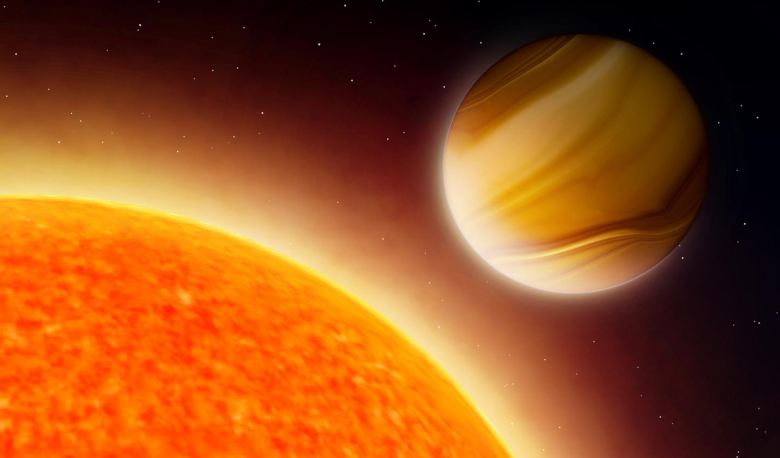The common H2O molecule that pervades our planet has been crucial for establishing complex life on Earth. So when research was published last year suggesting that our Milky Way could be teeming with water worlds, the hope of finding extraterrestrial life elsewhere got a serious boost.
Now however, one of the most extensive surveys of atmospheric chemical compositions of exoplanets to date has revealed trends that challenge that and other similar theories and instead suggests that while water is out there, it is not nearly as abundant as you might think.
Although over 4000+ exoplanets have now been discovered in the Galaxy, little is still known about the vast majority of these worlds. The mass and radius has been calculated for some planets, which has enabled scientists to infer what type of planet they may be, such as rocky or gas giant planets, but detailed studies on what chemical elements might dominate these far-off worlds are still few and far between.
Slowly aiming to change that is one team of researchers, led by the University of Cambridge, UK.
As part of a five-year research programme on the chemical compositions of planetary atmospheres outside our solar system, an international team led by researchers at the University of Cambridge, UK, examined atmospheric data from 19 exoplanets that span a large range in size - from 'mini-Neptunes' of nearly 10 Earth masses to 'super-Jupiters' of over 600 Earth masses - and temperature, from nearly 20 degrees celsius (C) to over 2000 C.
Aside from water, the team were also on the look-out for signs of sodium (Na) and potassium (K) as these elements can provide important constraints on how planets are formed.
Planetary systems, like our own, are born from a giant cloud of matter called a protoplanetray disk. First the star at its centre, in our case, the Sun, starts to grow and then the leftover material is swept up by any planets that start to form.
As the systems evolve though, the planets are expected to have different amounts of elements compared with the star, as the developing planet sucks in large amounts of ice, rock and other particles in a process called accretion.
Jupiter for example, has atmospheric proportions of hydrogen and helium that are in line with what is expected from the theoretical composition of the primordial solar nebula. But like Saturn, the two have a significantly higher amount of carbon (relative to hydrogen) in their atmospheres, when compared with the Sun because of this later accretion stage.
The abundances of other elements have been predicted to be similarly high in the atmospheres of giant exoplanets too - especially oxygen, which is the most abundant element in the universe after hydrogen and helium.
This means that water, which consists of an oxygen atom along with two hydrogen atoms, is also expected to be overabundant in such atmospheres.
After assessing extensive spectroscopic data collected from space-based and ground-based telescopes and performing detailed computational models and statistical methods, the team were able to obtain estimates of the chemical abundances in the exoplanet atmospheres across the sample.
Their results showed that six planets had an abundance of sodium (Na) and another six had an abundance of potassium (K), and that 14 of the 19 planets also contained water.
However, the overall trend in H2O abundances, from mini-Neptunes to hot Jupiters, is significantly lower when compared with the metal abundances for the Solar System (in astronomy, any element except for hydrogen and helium are classed as metals) and when compared with metallicity predictions for exoplanets, say the authors of their recent paper.
"We are seeing the first signs of chemical patterns in extra-terrestrial worlds, and we're seeing just how diverse they can be in terms of their chemical compositions," said project leader Dr Nikku Madhusudhan from the Institute of Astronomy at Cambridge, who first measured low water vapour abundances in giant exoplanets five years ago.
“It is incredible to see such low water abundances in the atmospheres of a broad range of planets orbiting a variety of stars,” he said.
Their results suggest a depletion of oxygen relative to other elements, rather than low overall metallicities. On the other hand, abundances for Na and K abundances in the gas giants are generally consistent with what is expected. As such, this poses problems for future atmospheric modelling which relies on these elements being equally abundant.
It also means that these planets may not have accreted as much ice as other gas giants as they formed.
Ultimately, more data will be needed to ascertain just how widespread this trend of low water abundance appears to be and how different elements can be differently enhanced.
“We look forward to increasing the size of our planet sample in future studies. Inevitably, we expect to find outliers to the current trends as well as measurements of other chemicals,” said” Madhusudhan. “Given that water is a key ingredient to our notion of habitability on Earth, it is important to know how much water can be found in planetary systems beyond our own,” he concluded.











